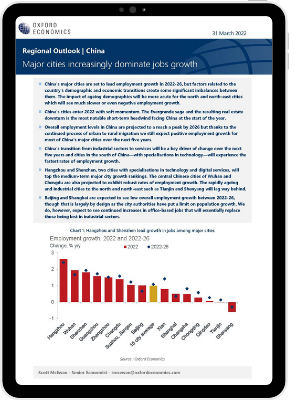Major cities increasingly dominate jobs growth in China
The next five years represent a turning point for employment levels in China. Due to ageing demographics the country’s working age population has been in decline since 2016, and by 2026 we project the level of employment will have peaked at approximately 760 million. Beyond 2026, China’s employment levels will begin to decline.
What you will learn:
- Overall employment levels in China are projected to a reach a peak by 2026 but thanks to the continued process of urban to rural migration we still expect positive employment growth for most of China’s major cities over the next five years.
- China’s transition from industrial sectors to services will be a key driver of change over the next five years and cities in the south of China—with specialisations in technology—will experience the fastest rates of employment growth.
- Hangzhou and Shenzhen, two cities with specialisations in technology and digital services, will top the medium-term major city growth rankings. The central Chinese cities of Wuhan and Chengdu are also projected to exhibit robust rates of employment growth. The rapidly ageing and industrial cities to the north and north-east such as Tianjin and Shenyang will lag way behind.

Related Resources

Post
How Asia’s supply chains are changing | Techonomics Talks
Global supply chains have continued to expand, despite talk of deglobalization and nearshoring. US and Japan have started to de-couple from China, but other G7 countries grow more dependent on Chinese inputs. Several "hotspots" are emerging across Asia with multiple winning formulas.
Find Out More
Post
China decoupling – how far, how fast?
Economic decoupling from China is ongoing, but the latest evidence suggests that, especially outside the US, the process is gradual and piecemeal. Trade decoupling may be slowly spreading from the US to other advanced economies, however surveys suggest foreign investors' attitudes to China improved slightly in 2023, though they are still more negative than a few years ago.
Find Out More